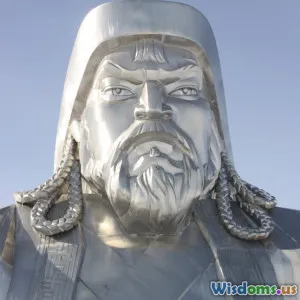
The Surprising Economic Legacy of the Medici Family
8 min read Explore how the Medici family shaped modern economics through banking, patronage, and innovation. (0 Reviews)
The Surprising Economic Legacy of the Medici Family
Throughout history, certain families stand out not just for their political power or artistic patronage but for leaving an indelible mark on economic systems that still resonate today. Among these, the Medici family of Florence holds a unique place. Far beyond their well-known role as great patrons of art and politics in Renaissance Italy, the Medici's economic legacy reveals insightful precedents in banking, economic innovation, and statecraft that helped shape modern economic paradigms.
Introduction
When one thinks of the Medici, visions of Renaissance art, Florence’s palatial splendor, or the Vatican often come to mind. Yet, the true depth of their legacy lies as much in economic innovation as in culture. From pioneering banking techniques to influencing the development of capitalism and public finance, the Medici family helped lay the groundwork for European economic growth. This article explores the surprising ways the Medici transformed commerce and state economics and how their innovations continue to influence modern financial systems.
The Rise of Medici Banking
Foundations of Modern Banking Institutions
The Medici Bank, established by Giovanni di Bicci de’ Medici in 1397, quickly rose to prominence as one of the most powerful financial institutions in Europe. Unlike traditional moneylenders who principally dealt in loans with high interest, the Medici bank employed innovative trust and investment mechanisms that reduced risk and expanded financial intermediation.
Key innovations included:
- Double-entry bookkeeping: While it existed prior, the Medici effectively utilized it to manage their growing and complex business operations.
- Branch networks: The bank operated across Europe—with offices in Rome, Venice, London, and Bruges—allowing cross-border transactions and currency exchanges.
- Bills of exchange: They popularized these instruments, precursors to modern checks and letters of credit, which facilitated safer and faster commercial transactions across countries.
The Medici’s client list included popes, monarchs, and aristocrats, demonstrating the trust and scale they achieved. Their banking practices established models that influenced the formation of the Bank of England and other central banks centuries later.
Managing Risk and Credit
Other economic legacies include how the Medici excelled in risk diversification. Instead of concentrating loans in one market, they spread investments across industries and regions—a strategy akin to modern portfolio theory before its time. This helped safeguard their wealth and maintain liquidity in volatile political climates.
Economic Patronage and Public Spending
Art, Science, and Economic Development
Beyond finance, the Medici’s role as patrons created lucrative economic ecosystems. Investing in artists such as Michelangelo, Leonardo da Vinci, and Botticelli was not merely cultural philanthropy—it was economic stimulation.
Their patronage attracted scholars and craftsmen, boosting demand for materials, supporting workshops, and encouraging technological innovation. Financial outlays on art and architecture had multiplier effects in Florence’s economy, catalyzing urban development and tourism.
Influencing Economic Policy and Governance
Members of the Medici family often held political power, shaping fiscal policy and governance. For instance, Lorenzo de’ Medici, known as 'The Magnificent,' encouraged fiscal stability by balancing public accounts and avoiding excessive taxation that could hamper economic activity.
This created an environment conducive to commerce and artisan production. His governmental approach foreshadowed modern economic principles advocating efficient taxation and public investment.
Medici Influence on Trade and Commerce
Facilitating International Trade
Thanks to their expansive banking networks and political influence, the Medici family were critical facilitators of international trade during the Renaissance—a period that sparked European globalization.
They financed maritime ventures, including voyages around Africa’s Cape of Good Hope, which opened new trade routes. They also supported merchants, lowering transaction costs through financial instruments and currencies that eased cross-border trades.
Currency Standardization and Economic Stability
The Medici’s role in currency stabilization helped foster economic certainty. Florence's gold coin, the fiorino d’oro, became a widely accepted currency due to its reliable purity and consistent weight, enhancing trust in financial transactions. This standardization promoted Florence as a financial hub.
Enduring Economic Lessons from the Medici
The Medici family's economic legacy is more than a historical footnote; it offers enduring lessons:
- Financial Innovation: Their banking models demonstrate the importance of innovation, trust, and risk management.
- Integration of Culture and Economics: Investments in the arts can drive economic growth and social capital.
- Economic Diversification: Spreading investments and influence across sectors can safeguard wealth and stability.
- Supportive Governance: Balancing taxation and public spending fosters a healthy business environment.
These principles influenced mercantilism and, eventually, modern capitalism. As economic historian Niall Ferguson notes, the Medici helped "invent the great capitalist era" by linking finance, politics, and culture in new ways.
Conclusion
The Medici family’s economic impact traversed centuries—from pioneering early banking systems to fostering an environment where commerce, culture, and politics intertwined. Their visionary approach to finance, patronage, and trade cultivated Renaissance Florence into an economic powerhouse and planted the seeds for modern financial institutions and economic thought.
Revisiting their legacy is not only a journey through history but a reminder of how innovation, cultural investment, and strategic governance can drive enduring economic prosperity. In an age seeking new economic models, the Medici story remains surprisingly relevant, inspiring new understanding of the symbiotic relationship between economic systems and society.
References:
- Goldthwaite, Richard A. The Economy of Renaissance Florence. Johns Hopkins University Press, 2009.
- Ferguson, Niall. The Ascent of Money: A Financial History of the World. Penguin Books, 2008.
- Kent, Dale. Cosimo de’ Medici and the Florentine Renaissance: The Patron’s Oeuvre. Yale University Press, 2011.
- Munro, John H. “The Medici Bank Reconsidered.” Journal of Economic History, vol. 41, no. 4, 1981, pp. 659–690.
By digging deeper into the Medici’s economic achievements, we uncover the foundation stones of our modern financial world.
Rate the Post
User Reviews
Popular Posts




















